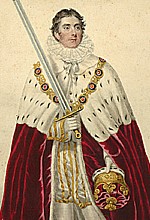Henry Pelham-Clinton, 4th Duke of Newcastle facts for kids
Quick facts for kids
The Duke of Newcastle
|
|
|---|---|

The 4th Duke of Newcastle-under-Lyne
|
|
| Lord Lieutenant of Nottinghamshire | |
| In office 1809–1839 |
|
| Preceded by | The Duke of Portland |
| Succeeded by | The Earl of Scarbrough |
| Personal details | |
| Born |
Henry Pelham Fiennes Pelham-Clinton
31 January 1785 |
| Died | 12 January 1851 (aged 65) Clumber Park |
| Resting place | All Saints' Church, West Markham |
| Nationality | British |
| Spouses |
Georgiana Elizabeth Mundy
(m. 1807; |
| Children |
|
| Parents | Thomas Pelham-Clinton, 3rd Duke of Newcastle-under-Lyne Lady Anna Maria Stanhope |
| Education | Eton College |
Henry Pelham Fiennes Pelham-Clinton, the 4th Duke of Newcastle-under-Lyne (born 31 January 1785 – died 12 January 1851), was an important British nobleman and politician. He played a big role in British politics during the late 1820s and early 1830s. From birth until 1794, he was known as Lord Clinton. Then, between 1794 and 1795, he was called the Earl of Lincoln.
Contents
Early Life and Education
Henry Pelham-Clinton was the oldest son of Thomas Pelham-Clinton, 3rd Duke of Newcastle-under-Lyne, and his wife, Lady Anna Maria. He went to Eton College, a famous school. His father passed away when Henry was only ten years old.
In 1803, during a break in the war with France, his mother and stepfather took him on a trip around Europe. This was called a "Grand Tour." But war started again, and Henry was held in Tours, France, from 1803 until 1806.
Political Career and Beliefs
When Henry returned to England in 1807, he had many advantages, including a lot of money. He married Georgiana Elizabeth Mundy, who was also very wealthy, on 18 July 1807.
He served as the Lord Lieutenant of Nottinghamshire from 1809 to 1839. This was a high-ranking position representing the King in the county. In 1812, he was made a Knight of the Garter, which is a very special honor.
Opposing Catholic Emancipation
The Duke of Newcastle was very active in politics, even though he didn't hold a national government job. He strongly believed in the traditional ways of the Church and State.
One of his main beliefs was against "Catholic Emancipation." This was a movement to give Roman Catholics more rights, like being able to hold public office. On 22 March 1821, he wrote a public letter explaining why he thought this was a bad idea.
He argued that the government should not support Catholic Emancipation. He believed that if the King approved such a law, it would go against his promise to protect the Protestant faith, which he made when he became King.
Around 1826, the Duke became a leader of a group called the "Ultra-Tories." These were politicians who strongly supported the old traditions and opposed many changes. He met with King George IV to share his views. He wanted the King to choose government leaders who were also against Catholic Emancipation.
Views on Electoral Reform
The Duke of Newcastle was also strongly against "electoral reform." This meant changing the rules about who could vote and how parliamentary seats were divided. He believed the old system was best.
His strong views led to problems during the Reform Bill Riots in 1831. People who wanted reform attacked his properties. Nottingham Castle was burned down, and his homes in Clumber Park and Portman Square, London, had to be protected from angry crowds.
In 1829, when he was criticized for removing tenants who voted against his chosen candidates, he famously said: "Is it presumed then that I am not to do what I will with my own?" This showed his belief that he had complete control over his property and those who lived on it.
In 1839, he disagreed with the government's choice of new local officials because they were not of his political or religious views. He wrote a very strong letter to the Lord Chancellor. Because he refused to take back his letter, he was removed from his role as Lord Lieutenant of Nottinghamshire.
Family Life
On 18 July 1807, Henry Pelham-Clinton married Georgiana Elizabeth Mundy. She was the only child and heir of Edward Miller Mundy. They had eight sons and six daughters together.
Their children included:
- Lady Anna Maria Pelham-Clinton (1808–1822)
- Lady Georgiana Pelham-Clinton (1810–1874)
- Henry Pelham-Clinton, 5th Duke of Newcastle-under-Lyne (1811–1864), who later became the 5th Duke.
- Lady Charlotte Pelham-Clinton (1812–1886)
- Lord Charles Pelham Pelham-Clinton (1813–1894)
- Lord Thomas Charles Pelham-Clinton (1813–1882)
- Lord William Pelham-Clinton (1815–1850)
- Lt. Lord Edward Pelham-Clinton (1816–1842), who died during the First Opium War.
- Lord John Pelham-Clinton (1817–1817), who died as a baby.
- Lady Caroline Augusta Pelham-Clinton (1818–1898)
- Lady Henrietta Pelham-Clinton (1819–1890)
- Lord Robert Renebald Pelham-Clinton (1820–1867)
Sadly, the Duchess of Newcastle-under-Lyne died in 1822 while giving birth. To remember her, the 4th Duke built a church and a special burial place (mausoleum) in Milton, Nottinghamshire.
The 4th Duke never married again. He passed away at Clumber Park, Nottinghamshire, on 12 January 1851. He was buried in All Saints' Church, West Markham. His oldest son, Henry, became the 5th Duke of Newcastle and was also an important politician.
Legacy
The Duke of Newcastle's personal writings, including his detailed diaries from 1822 to 1851, are kept at The University of Nottingham. These papers help historians understand more about his life and the politics of his time.

